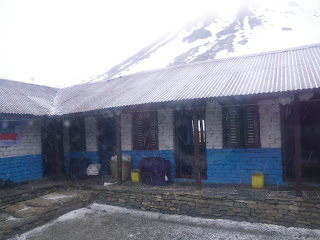From the train station in Amritsar we catch the free bus straight to the Golden Temple, where we head for the free accommodation intended for pilgrims but open to travellers as well. The traveller dorm is filled with wall to wall (and mattress to mattress) beds save a small path down one side. There are people sprawled on every surface, including the limited floor space. We carefully step over the sleeping bodies looking for a spare space, but give up when one boy points to his mattress, then his skin and starts scratching. Bed bugs. We decide we are not on such a tight budget after all, make a swift exit and fork out the 500 rupees for a hotel around the corner.
The Golden Temple complex is huge, but the actual temple is smaller than I expected. It is of course beautiful, there is not much to say on that count. After so many crazy, noisey, monkey-filled Hindu temples it is nice to be in a much calmer Sikh atmosphere. Although, like Hindu holy sights, there are still people washing in rather dirty water.
However, it's best point in my opinion is the free meal they dish out to anyone who wants it. The kitchen serves 10,000 black dal and chapatti meals a day, and the whole thing is a very smooth operation. As we walk up the steps we are handed a plate from a volunteer on our right, and a mug and cutlery from our left. We sit down on mats in the dining room and immediately more volunteers come and slop food onto our plates quickly but neatly. There are families, couples, individuals, Sikhs, Hindus, very well dressed people, shabby people and other travellers. Sharing a meal with strangers is intended to reinforce the principle of equality in the Sikh faith, but everyone eats immediately and in silence, and within 10 minutes people are leaving. One man walks down the aisles splashing water on the floor and another follows with a huge mop. We carry our plates and cutlery outside where they are taken by anther volunteer, sorted and passed along a human chain into a huge washing up bath manned by 3 people on each side. We also walk past the kitchen, filled with cooking pots big enough to fit several small children, and a group of women furiously peeling vegetables.
Like everything else entry to the temple is free, and we come back several times through out the day to soak up the peaceful atmosphere and the heavily subsidised coca-colas (5 rupees!). My favourite time is the evening, when the entire complex is lit up.
The Golden Temple complex is huge, but the actual temple is smaller than I expected. It is of course beautiful, there is not much to say on that count. After so many crazy, noisey, monkey-filled Hindu temples it is nice to be in a much calmer Sikh atmosphere. Although, like Hindu holy sights, there are still people washing in rather dirty water.
However, it's best point in my opinion is the free meal they dish out to anyone who wants it. The kitchen serves 10,000 black dal and chapatti meals a day, and the whole thing is a very smooth operation. As we walk up the steps we are handed a plate from a volunteer on our right, and a mug and cutlery from our left. We sit down on mats in the dining room and immediately more volunteers come and slop food onto our plates quickly but neatly. There are families, couples, individuals, Sikhs, Hindus, very well dressed people, shabby people and other travellers. Sharing a meal with strangers is intended to reinforce the principle of equality in the Sikh faith, but everyone eats immediately and in silence, and within 10 minutes people are leaving. One man walks down the aisles splashing water on the floor and another follows with a huge mop. We carry our plates and cutlery outside where they are taken by anther volunteer, sorted and passed along a human chain into a huge washing up bath manned by 3 people on each side. We also walk past the kitchen, filled with cooking pots big enough to fit several small children, and a group of women furiously peeling vegetables.
Like everything else entry to the temple is free, and we come back several times through out the day to soak up the peaceful atmosphere and the heavily subsidised coca-colas (5 rupees!). My favourite time is the evening, when the entire complex is lit up.


























































